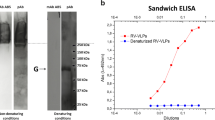Summary
Antibody quantification by EIA is possible without a standard curve. Following the so-called alpha method only one test dilution is used, the resulting absorbance is corrected and the IU/ml will be calculated by means of a mathematical formula. This new kind of a single point measurement was evaluated in seven independent laboratories by comparison with commercial EIAs using a standard curve or a titer calibration line. For the quantification of IgG against rubella virus this study comprised 1,480 individual samples and three comparison EIAs. For IgG againstToxoplasma gondii a total of 743 samples was evaluated in two comparison tests. The results obtained by the alpha method show a precision and accuracy more than sufficient for routine testings. Also the technical expenses and reagent costs were reduced. Prerequisites and limitations are discussed against the background of the problem of immune status definition.
Zusammenfassung
Die Antikörperquantifizierung ist im EIA auch ohne Standardkurve möglich. Bei der sogenannten Alpha-Methode wird nur eine Testverdünnung benötigt, das Meßsignal korrigiert und dann über eine Rechenformel die IU/ml ermittelt. Diese neue Einpunktquantifizierung wurde in sieben unabhängigen Arbeitsgruppen durch Vergleich mit kommerziellen EIA's bewertet, die eine Standardkurve oder Titerbezugsgerade verwenden. Zur IgG-Quantifizierung bei Rubella wurden insgesamt 1480 einzelne Untersuchungsproben und drei Vergleichs-EIA's eingesetzt. Beim IgG gegenToxoplasma gondii waren es über alles 743 Proben und zwei Vergleichstests. Die mittels Alpha-Methode erzielten Ergebnisse besaßen eine voll praxistaugliche Präzision und Richtigkeit. Zusätzlich wurden der technische Aufwand und die Reagenzienkosten reduziert. Voraussetzungen und Einschränkungen werden vor dem problematischen Hintergrund einer Immunstatusdefinition diskutiert.
Similar content being viewed by others
References
De Savigny, D., Voller, A. The communication of ELISA data from laboratory to clinician. J. Immunoassay 1 (1980) 105–128.
van Loon, A., van der Veen, J. Enzyme-linked immunosorbent assay for quantitation of toxoplasma antibodies in human sera. J. Clin. Pathol. 33 (1980) 635–639.
Felgner, P. Stepless antibody determination with the Stick-ELISA technique. Results expressed as multiple of normal activity (MONA). Zbl. Bakt. Hyg., I. Abt. Orig. A 242 (1978) 100–105.
Dopatka, H. D., Giesendorf, B. Single point quantification of antibody by ELISA without need of a reference curve. J. Clin. Lab. Anal. 6 (1992) 417–422.
Voller, A., Bidwell, D. E., Bartlett, A.: The enzyme linked immunosorbent assay (ELISA). A guide with abstracts of microplate applications. In: Dynatech Europe Borough House, Rue du Pre, Guernsey, G. B. (1979) p. 37.
Kramer, S. M., Jewell, N. P., Cremer, N. E. Driscriminant analysis of data in enzyme immunoassay. J. Immunol. Methods 60 (1983) 243–255.
Whittington, R. J. Evaluation of a simple method for improving the precision of an ELISA detecting antibody in serum. J. Immunol. Methods 148 (1992) 57–64.
Dimech, W., Bettoli, A., Eckert, D., Francis, B., Hamblin, J., Kerr, T., Ryan, C., Skurrie, I. J. Multicenter evaluation of five commercial rubella virus immunoglobulin G kits which report in international units per milliliter. J. Clin. Microbiol. 30 (1992) 633–641.
Pustowoit, B., Hofmann, J., Trauer, H. Eine erste Beurteilung des Einsatzes der α-Methode. In-Vitro Diagnostika Nachrichten 7 (1993) 6.
Best, J. M., Harcourt, G. C., Druce, A., Palmer, S. J., O'Shea, S., Banatvala, J. E. Rubella immunity by four different techniques: results of challenge studies. J. Med. Virol. 5 (1980) 239–247.
O'Shea, S., Parsons, G., Best, J. M., Banatvala, J. E. How well do low levels of rubella antibody protect? Lancet ii (1981) 1284.
Mortimer, P. P., Edwards, J. M. B., Porter, A. D., Tedder, R. S., Mace, J. E., Hutchinson, A. Are many women immunized against rubella unnecessarily? J. Hyg. Camb. 87 (1981) 131–138.
Francis, B. H., Hatherley, L. L., Walstab, J. E., Taft, L. I. Rubella screening and vaccination programme at a Melbourne maternity hospital. A five-year review. Med. J. Aust. 1 (1982) 502–504.
Skurrie, I. J., Head, J. L., Garland, S. M. Detection of rubella-specific immunoglobulin G: comparison of enzyme-linked immunosorbent assay and an automated microparticle enzyme immunoassay (IMX). J. Clin. Microbiol. 29 (1991) 1752–1753.
Mutterschaftsrichtlinien. Deutsches Ärzteblatt B, 81 (1984) 631.
Kunz, Ch. Virusepidemiologische Informationen 14 (1991). In: Veröffentlichung der Biochemie GmbH — Diagnostika, Wien.
Desmonts, G., Couvreur, J., Thuilliez, P., Saint-Joigny, G., Colin, J.: Sérodiagnostic de la toxoplasmose acquise des méthodes simples, pour des questions précises. Le concours médical (1985) 227–229.
Garin, J. P. Toxoplasmose: aspects nouveaux dans la surveillance de la femme enceinte et du nouveau-né. Feuillet de Biologie 29 (1988) 21.
Paris-Hamelin, A. Toxoplasmose: Techniques proposées, aspects pratiques, avantages, inconvénients. Feuillet de Biologie 29 (1988) 33–35.
Valtaud, E., Lacroix, C., Rodier, M. H., Toullat, G., Jacquemin, J. L. Etude critique d'une technique ELISA et d'un test d'agglutination directe haute sensibilité pour le dépistage des IgG antitoxoplasmiques. Ann. Biol. Clin. 49 (1991) 357–400.
Author information
Authors and Affiliations
Rights and permissions
About this article
Cite this article
Martens-Düring, B., Dopatka, H.D. Multicenter evaluation of a novel quantification method for rubella and toxoplasmosis antibodies. Infection 22, 293–298 (1994). https://doi.org/10.1007/BF01739924
Issue Date:
DOI: https://doi.org/10.1007/BF01739924




